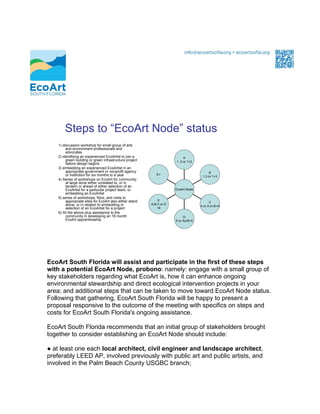Node steps
- 1. Steps to âEcoArt Nodeâ status 1) discussion workshop for small group of arts and environment professionals and advocates 2) identifying an experienced EcoArtist to join a A green building or green infrastructure project 1, 2 or 1+2 before design begins 3) embedding an experienced EcoArtist in an appropriate government or nonprofit agency B or institution for six months to a year E+ 1,3 or 1+3 4) Series of workshops on EcoArt for community at large done either unrelated to, or in tandem or ahead of either selection of an EcoArtist for a particular project team, or EcoArt Node embedding an EcoArtist 5) series of workshops, films, and visits to appropriate sites for EcoArt also either stand E C alone, or in relation to embedding or A,B,C or D 4 or A or B+4 selection of an EcoArtist for a project +6 6) All the above plus assistance to the community in developing an 18 month D EcoArt apprenticeship 5 or AorB+5 EcoArt South Florida will assist and participate in the first of these steps with a potential EcoArt Node, probono: namely: engage with a small group of key stakeholders regarding what EcoArt is, how it can enhance ongoing environmental stewardship and direct ecological intervention projects in your area; and additional steps that can be taken to move toward EcoArt Node status. Following that gathering, EcoArt South Florida will be happy to present a proposal responsive to the outcome of the meeting with specifics on steps and costs for EcoArt South Florida's ongoing assistance. EcoArt South Florida recommends that an initial group of stakeholders brought together to consider establishing an EcoArt Node should include: â at least one each local architect, civil engineer and landscape architect, preferably LEED AP, involved previously with public art and public artists, and involved in the Palm Beach County USGBC branch;
- 2. â one or more local artists who have been actively engaged with environmental advocacy, preferably also who have experience in public art projects where they have worked closely across discipline with other design professionals (architects, engineers, landscape architects); â environmental professionals in local municipal government agencies, and the South Florida Water Management District, preferably who have worked with public art previously--preferably also LEED APs; â local university professors in art and environmental science departments, especially any who have already worked to team teach courses in environmentally-oriented art; â leaders in the most active environmental advocacy organizations in the county (eg Sierra Club, Florida Native Plant Society, Audubon Society, 1000 Friends of Florida), especially those who have been involved with public art previously; â sustainability staff at the municipal level; â art in public places professionals (curators, project managers, etc.) and/or AIPP committee chairs or board members. Please contact us for questions or additional information: mjaagerstoun@ecoartsofla.org 561-881-5658


